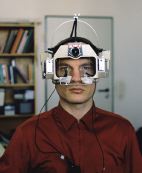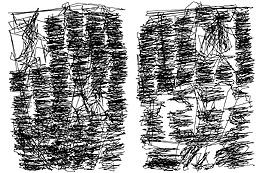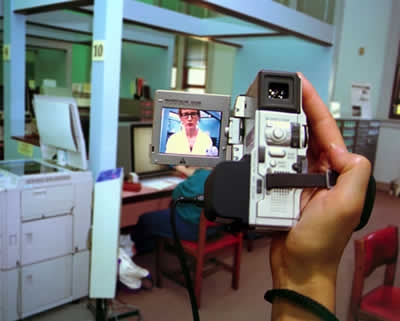010101: ART IN TECHNOLOGICAL TIMES
HAPPENINGText: Amy Balkin
Sculptors Karin Sander and Roxy Paine both share a gallery and employ hands-off approaches to the creative process. And both let the machines they use determine the aesthetic of their output. Sander’s “1:10” (1999-2000) is a series of highly detailed and naturalistic miniature figures. Created at 1/10th scale by feeding full-body 3-D scans to a computer driven fabricator generated sculptures using a process usually reserved for industrial prototyping.
Skumak Machine, Roxy Paine, 2000
Roxy Paine‘s laptop drives his “Skumak Machine” to make sculptures by extruding plastic in randomized intervals onto a conveyer belt. The accumulated globby red stacks displayed on a table across from the machine points to the possibility of mass production of art and the lack of artist involvement.![]()


EYE and Newspaper, Jochem Hendricks, 2000
Jochem Hendricks uses a retinal scanner to create drawings that document how his eyes track through a reading of the main Silicon valley newspaper The San Jose Mercury News. Newspapers printed with the scratchy output of this experiment resemble methampetamine-fueled etchings and reveal the form of the papers layout beyond its words. The paper is available for purchase in a kiosk in the museum.

The Telephone Call (2001), Janet Cardiff Audio and video walk through San Francisco Museum of Modern Art, Duration: 17:00, Media: digital video, equipment: mini DV camera and headphones Courtesy of the artist
And don’t miss Janet Cardiff‘s video walkthrough, one of the highlights of the show. You have to trade your credit card and ID in the museum lobby for an ultralight handycam and headset to experience her parallax-inducing narrative set in the museum.
In contrast to projects like these some work seemed to lack unclear direction beyond showcasing consumer electronics like plasma screens and G4 laptops. And projects by designers were particularly disappointing. Both Droog Design’s and Karim Rashid’s projects seemed thrown together during an overly hectic work period.
Designed by Perimetre-Flux, the 010101 web site is ambitious in its scale and beautiful in its execution, however for functional access to information about the show a user would be better to go to the PR site (unfortunately locked to the public). That said the official website for the show should be visited to appreciate the bold graphic design and experimental interactive components, as well as being a portal to. Unlike many flash sites, the 010101 site invites lasting user participation through a visual message board. Unlike many regular html message boards on the web, the 010101 site graphically reveals the reply structures of the posts in a branching hierarchical structure. While this is a technical feat and a step in the right direction for flash sites which often lock out the user from any lasting interaction with each other, it fails in the familiar flash way of making any such interaction hidden by the whizziness of the interface itself. In the end it would have been more fruitful for the conversation to have been able to read the text upfront with out having to rollover and click through each individual posting.
While ultimately uneven in its execution, 010101 and it’s attendant web site are both commendable in their willingness to state a perspective in an elusive and evolving area. While this show is not definitive of art in technological times; like our times, it is messy, innovative, and containing at least as many failures as successes.
010101: Art in Technological Times
Date: March 3rd – July 8th, 2001
Open: 10:00 – 18:00 (Thursday till 21:00)
Closed on Wednesdays
Place: SF MoMA
Address: 151 Third St., San Francisco, CA 94103
Tel: +1 415 357 4000
https://www.sfmoma.org
Text: Amy Balkin
Translation: Josh On
Photos: Courtesy of San Francisco Museum of Modern Art




